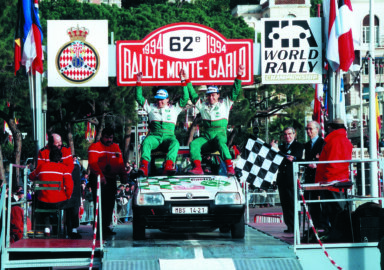Favorit: a name synonymous with motorsport success
In the late 1980s, Škoda Auto underwent a significant transformation. This change was embodied in the Škoda Favorit, marking a revolutionary shift from the long-standing era of rear-engine, rear-wheel-drive models to a modern car with a spacious body, front-mounted engine, and front-wheel drive. At the same time the series-production model was rolling off the production line, a racing variant was developed from 1988, receiving homologation on 1 January 1989. The Škoda Favorit 136 L made its official competition debut in January 1989 at the Wallachian Winter Rally, with teams Ladislav Křeček/Bořivoj Motl and Pavel Sibera/Petr Gross.
The Škoda Favorit then stepped onto the international stage at the Finnish Hankiralli, where it proved its mettle in the premier ‘competitive’ league in Finland. The local team of Kalevi Aho/Timo Hakala clinched a class victory with the Favorit. At the time, few could have predicted the impact the Škoda Favorit would have either in Mladá Boleslav motorsport or the global rally stages.
Monte Carlo Rally 1994: fourth consecutive victory in the under 1300 cm³ class
Technical innovations and experienced, motivated teams led to extraordinary results in the 1994 season. The harbinger of this successful campaign was a victory at the 62nd Monte Carlo Rally in January. The Sibera/Gross team continued their winning streak in the under 1300 cm³ class to secure their fourth consecutive victory in this challenging competition. Vladimír Berger and Pavel Štanec clinched second place in the class in their Škoda Favorit, with the third-place competitor trailing the Czech victors by over half an hour. Despite the Favorit’s modest performance compared to the global competition, Pavel Sibera reached an impressive 20th place in the overall rankings.
According to the drivers, the car handled like a go-kart, evidenced by its tendency to lift onto two wheels rather than skidding during fast cornering.
Outstanding 1994 season and victory in the FIA World Championship
The Škoda Motorsport team built on its initial success at the challenging Portuguese rally. Here, the Czech teams with Škoda Favorit cars showcased their class dominance, with the Sibera/Gross team celebrating victory followed by the Triner/Klíma crew. Additionally, Pavel Sibera battled his way to 10th place overall, earning valuable points for Škoda in the Manufacturers’ World Championship.
At the May Acropolis Rally, both cars broke into the overall Top 10, marking a historic accomplishment for the Škoda brand in the world championship. The cars in the first eight positions were factory racing specials equipped with much more powerful turbocharged engines, which makes the success all the more impressive.
The Škoda Favorit reaffirmed its performance in the Finnish rally and even in Australia, where the Škoda Motorsport team was venturing for the first time, eyeing the FIA World Championship title. Additional points were secured at Rallye Sanremo and the Spanish rally. Heading into the famous British RAC Rally, which celebrated its 50th anniversary in 1994, the task was clear: to defend their leading position in the FIA World Championship in the under two-litre class. Competing in the A5 class for naturally aspirated, front-wheel-drive cars with engines up to 1300 cm³, Škoda not only won this category but also impressively placed 6th and 7th in the larger 2-litre class. This performance in both classes led to Škoda securing the manufacturer’s trophy in the FIA 2-litre World Rally Championship. Škoda thus dominated an official FIA Championship for the second time in its history, the first being in 1981 when it won the European Touring Car Championship.
Ending on a high note
After Škoda Motorsport team leader Pavel Janeba received the prestigious trophy at the Monte Carlo ceremony on 9 December 1994, another historic moment followed a few days later at Prague Castle’s Imperial Stables: The Škoda Favorit officially concluded its racing career, and the press were introduced to its successor – the Škoda Felicia Kit Car. Under the factory team banner, the racing Favorit entered 35 World Championship competitions, notching an impressive 31 victories and 20 second-place finishes in its class record.
Background information
Škoda Favorit 136 L Rally Special
This competition car, homologated for Group A, was based on the production model, featuring a five-door steel body with a protective frame made of thin-walled chromolybdenum tubes, and weighed in at 750 kg. It was powered by an aluminium, water-cooled four-cylinder OHV engine with an eight-channel head and a single carburettor. The engine was mounted transversely in the front and powered the front wheels. From a displacement of 1289 cm³, the Mladá Boleslav engineers managed to extract 120 horsepower. Depending on the type of competition and the resulting gearing of the six-speed manual transmission, the car achieved top speeds of 150 to 210 km/h. The braking was handled by four disc brakes.
Škoda Cars at the Monte Carlo Rally
Motorsport has been a cornerstone of the Mladá Boleslav automaker’s legacy since its foundation, and the brand has won numerous valuable trophies at the prestigious Monte Carlo Rally. Laurin & Klement vehicles raced as early as the rally’s second staging in 1912, and in 1936, a model with the winged arrow in its logo was on the start line for the first time: the Škoda Popular Sport roadster finished second in the under 1500 cm³ category. Post-World War II, Škoda established itself as a strong competitor in the under 1300 cm³ class, evidenced by the Octavia TS model’s hat trick from 1961 to 1963. In the 1990s, the Favorit 136 L model continued Škoda’s successes in Monte Carlo, with four consecutive class victories from 1991 to 1994. The modern era is marked by Škoda Fabia competition cars with all-wheel drive: the Škoda Fabia R5 clinched the WRC2 category at the MCR in 2018.
The post Three decades on: Remembering the Škoda Favorit’s four consecutive Monte Carlo Rally victories appeared first on Škoda Storyboard.
